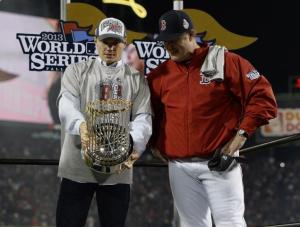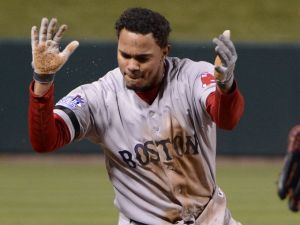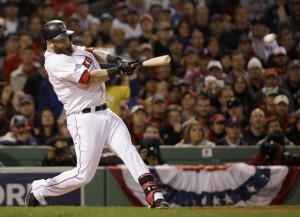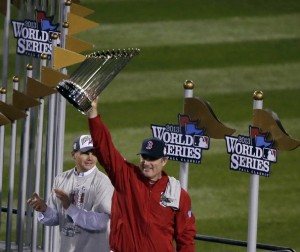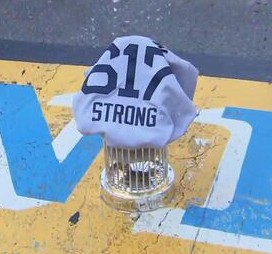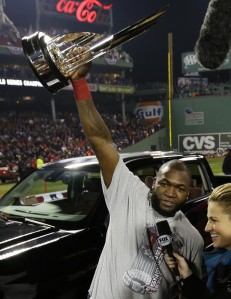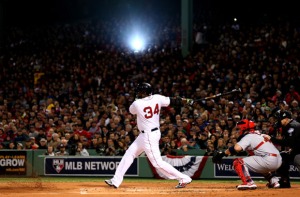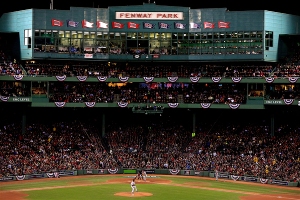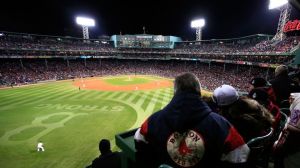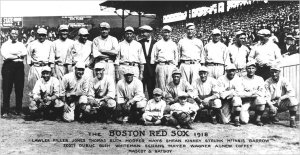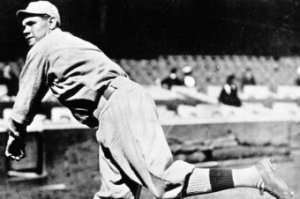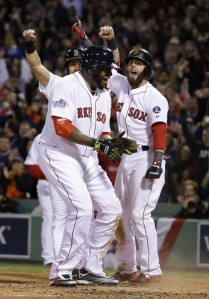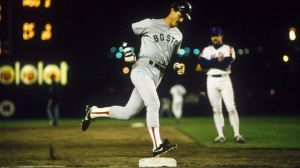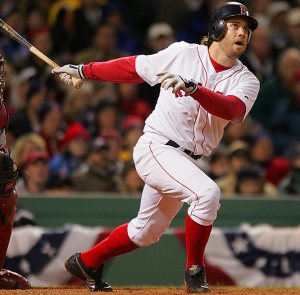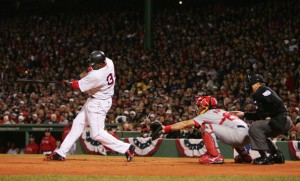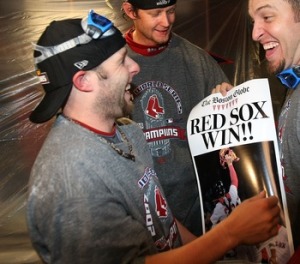Tagged: 2013 World Series
A few pressing questions for the Red Sox….
The duck boats have yet to be parked following Saturday’s celebratory parade, but some pressing business is already upon Red Sox general manager Ben Cherington and his baseball operations staff.
In the wake of their third World Series triumph in 10 years, Red Sox players have expressed deep admiration for one another. As much as any team in recent memory, this was a united crew. To a man, they would love to keep it together.
Yet to a man, they understand that business often comes first, and Boston will have a different look when it reconvenes in Fort Myers to begin the process of defending its crown. Red Sox president Larry Lucchino admitted as much Friday morning.
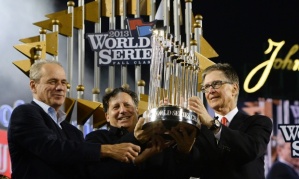
“I can’t give you a precise answer as to how many players will come and how many will go,” Lucchino said in an interview on Boston sports radio station WEEI. “We love the core of this team. We know the core of this team will be here and be with us. We know we have some new players who were signed for a couple of years, like Jonny Gomes and David Ross. So we do know that the core of this team will remain. But there’s absolutely no chance that the 25 guys who finished in the World Series will be the same 25 guys who will start Opening Day next year.”
Seven Red Sox players were among the 147 players who officially filed for free agency Thursday: catcher Jarrod Saltalamacchia, first baseman Mike Napoli, outfielder Jacoby Ellsbury, shortstop Stephen Drew, relief pitcher Joel Hanrahan, infielder John McDonald, and pitcher Alfredo Aceves, who was exiled to the minors last season.
Free agents can begin to sign with new teams beginning at 12:01 a.m. ET Tuesday. Until that time, they are not eligible to negotiate contract terms with a new team, although they and their representatives are allowed to talk with any team about a potential match. Teams retain exclusive negotiating rights with their free agents until that time.
But in the interim, the Sox must also decide whether they will extend a qualifying offer to their free agents, which determines whether they will receive draft-pick compensation if a free agent leaves.
Qualifying offers must be extended by 5 p.m. Monday. The value of a qualifying offer has been calculated by formula to be a one-year guarantee of $14.1 million for 2014. Any player accepting a qualifying offer is considered to be a signed player. A free agent has until 5 p.m. on Nov. 11 to accept a qualifying offer. If he declines a qualifying offer and signs with another big league team, his former team receives an amateur draft choice as compensation, while the signing team forfeits its highest available draft pick and the accompanying bonus pool money in the draft.
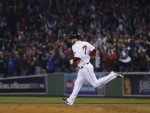 What do you do with the left side of the infield? Shortstop Stephen Drew is a free agent and will be coveted in a market that features very little at the position. Because of that fact, he may be inclined to turn down any qualifying offer (one year, $14.1 million) the Red Sox give him and seek a long-term deal elsewhere. If that’s the case, Xander Bogaerts slides right on in, likely leaving Will Middlebrooks to man third base.
What do you do with the left side of the infield? Shortstop Stephen Drew is a free agent and will be coveted in a market that features very little at the position. Because of that fact, he may be inclined to turn down any qualifying offer (one year, $14.1 million) the Red Sox give him and seek a long-term deal elsewhere. If that’s the case, Xander Bogaerts slides right on in, likely leaving Will Middlebrooks to man third base.
But is that ideal for the Sox?
Middlebrooks’ up-and-down (but mostly down) 2013 campaign, coupled with a lackluster October, casts some doubt as to whether he is ready to be an everyday player in the majors. Meanwhile, Bogaerts looked like a 10-year veteran as the club’s third baseman in the World Series. Both he and the organization have said Bogaerts is a shortstop, but another year (at age 21) at the hot corner would not hinder his future at another position.
At the same age, Cal Ripken Jr. played the first half of his first full season at third base. Perhaps if the team finds a way to keep Drew, who doesn’t turn 31 until March, Bogaerts could do the same and Middlebrooks could be dealt or moved across the diamond to first base, if Mike Napoli moves on.
Will Salty return? Jarrod Saltalamacchia told ESPN prior to Game 6 that he had already wondered if he was spending his final few days as a Red Sox. David Ross, who is signed for next year, was John Farrell’s choice in the final three games of the World Series.
It seems as if we have been hearing his name forever, but Saltalamacchia is still just 28 and is coming off his best all-around offensive season (.273 average, 14 homers, .804 OPS). He fits in the clubhouse and with the pitching staff, and if the Sox see him continuing to improve defensively, a qualifying offer could be in the cards.
That could change if the organization feels that Ryan Lavarnway is ready enough to split time with Ross, or if it makes a push for someone like free agent Brian McCann. Prospect Blake Swihart could be knocking on the door in another year or so, and Christian Vazquez had a solid season at the plate and behind it at Double-A Portland, so more help is on the horizon.
 What’s the long-term future of Jon Lester? Boston will exercise its option for Lester for next year, which carries with it a $13 million price tag. His value is at an all-time high after a brilliant October (4-1 with a 1.56 ERA in five starts), and discussions of a long-term deal may be forthcoming. The Sox gave Josh Beckett and Clay Buchholz lengthy, pricy extensions in recent years. They also gave John Lackey a five-year, $82.5 million deal and Ryan Dempster a two-year, $26.5 million contract, then took on Jake Peavy’s $14.5 million salary for 2014. If there’s anything left over, locking up a durable, homegrown ace who is not yet 30 seems like a no-brainer.
What’s the long-term future of Jon Lester? Boston will exercise its option for Lester for next year, which carries with it a $13 million price tag. His value is at an all-time high after a brilliant October (4-1 with a 1.56 ERA in five starts), and discussions of a long-term deal may be forthcoming. The Sox gave Josh Beckett and Clay Buchholz lengthy, pricy extensions in recent years. They also gave John Lackey a five-year, $82.5 million deal and Ryan Dempster a two-year, $26.5 million contract, then took on Jake Peavy’s $14.5 million salary for 2014. If there’s anything left over, locking up a durable, homegrown ace who is not yet 30 seems like a no-brainer.
What about David Ortiz? While similar to Lester in some ways, the Ortiz situation is a little murkier. Many observers felt as if the organization had lost its mind when it gave the slugger, at the time 36 and rehabbing from an Achilles injury, a two-year deal that will now total $30 million due to an achieved incentive this year. When that contract expires after the 2014 season, would Ortiz — who would then be approaching 39 — seek one more multiyear deal elsewhere? And do the Sox want to prevent one of the cornerstones of their franchise from leaving?
As crazy as it seemed to lock him up last offseason, it would be awkward to let the World Series MVP go too far into the final year of his deal with an uncertain future. An extension beyond 2014 could be in his future.
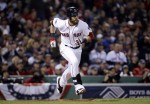 Bid adieu to Jacoby Ellsbury? There have been whispers for months that the two sides are far apart in negotiations. ESPN’s Buster Olney reported this week that a $30 million gap existed after Ellsbury’s phenomenal 2011 season and that the sides could not get together again after his down 2012. With Ellsbury a Scott Boras guy, the long-held assumption has been that the center fielder has been waiting to test the free-agent waters. Coming off a much better 2013 (.298 average, 52 steals) seems like a great time to do so.
Bid adieu to Jacoby Ellsbury? There have been whispers for months that the two sides are far apart in negotiations. ESPN’s Buster Olney reported this week that a $30 million gap existed after Ellsbury’s phenomenal 2011 season and that the sides could not get together again after his down 2012. With Ellsbury a Scott Boras guy, the long-held assumption has been that the center fielder has been waiting to test the free-agent waters. Coming off a much better 2013 (.298 average, 52 steals) seems like a great time to do so.
Boston’s aggressiveness in this matter rests largely in its opinion of Jackie Bradley Jr. The youngster had a rough time in his first stint in the big leagues in April but looked a bit more comfortable in his Red Sox skin once he was called up again in September, even getting support from some to be included on the postseason roster.
Bradley will not disappoint in the field; he has range and a great arm. Enduring some growing pains at the plate would hurt much less than paying Ellsbury upward of $18 million when he is 36 and beginning to break down. Not saying that would necessarily happen, but it’s the risk you run with big-money long-term deals, and Bradley will come at a pittance as he approaches his prime.
Who’s on the bench? The 2013 Red Sox did not have many holes. However, there were times when it felt as if they needed one more utility guy in the infield. Brock Holt and Brandon Snyder did not impress in their brief stints, and once Jose Iglesias left, there was a relative lack of options some nights if one of the starters went down.
To illustrate the conundrum, Middlebrooks stood as Dustin Pedroia’s backup for a handful of games. Veteran John McDonald was brought in late to add an extra hand, and Bogaerts’ call-up gave the club another option, but the organization would do well to bring in an Alex Cora-type who can ably back up multiple spots. Someone with speed who can play center would help even more if Ellsbury leaves and Bradley needs a backup.
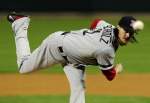 Lester-Buchholz-Lackey-Peavy-? Pencil in Lester, Buchholz, Lackey and Peavy as the top four starters. Who gets the No. 5 spot? Felix Doubront made strides in 2013 and figures to have earned it, but Dempster is on the books for $13.25 million. Also, waiting in the wings are a few young, intriguing arms who could make a push, including Allen Webster and Anthony Ranaudo.
Lester-Buchholz-Lackey-Peavy-? Pencil in Lester, Buchholz, Lackey and Peavy as the top four starters. Who gets the No. 5 spot? Felix Doubront made strides in 2013 and figures to have earned it, but Dempster is on the books for $13.25 million. Also, waiting in the wings are a few young, intriguing arms who could make a push, including Allen Webster and Anthony Ranaudo.
Chances are Doubront gets a spot, Dempster serves as an expensive long man/spot starter, a la Tim Wakefield late in his career, or gets traded, and the youngsters are given more time to prepare for when somebody goes down.
And somebody will go down.

The Sox were actually quite fortunate to suffer only one long-term injury among starters, that being Buchholz’s three-month absence. There will be injuries, and having the depth to atone for them is as important as anything through the course of a long season.
 Bring back Nap? “I want to be here. I love this place.”
Bring back Nap? “I want to be here. I love this place.”
That was Mike Napoli after the World Series triumph. Lines like that one are thrown around like empty beer cans during such celebrations, but it is clear that Napoli has been a nice fit in Boston.
Napoli’s agent told the Boston Globe that his client would not accept another one-year deal, and that the club would analyze the condition of Napoli’s hips to see if there has been any significant wear and tear since the last checkup. With a clean bill of health, perhaps something like the three-year, $39-million deal that the two sides reportedly agreed on last offseason — before the discovery of the hip condition altered things — could become a reality. Napoli agreed to a $5 million base salary for 2013 but earned the full $13 million with incentives.
The Sox will likely make a qualifying offer to Napoli and receive a draft pick if he elects to move on, but expect the man who ranked second on the team in home runs (23) and RBIs (92), and who surprised some with a quality showing at first base, to return.
The easy decisions on making qualifying offers include Ellsbury, who is expected to be one of the most highly sought free agents on the market, and Napoli, one of the few power bats available on the market. Neither is likely to accept a qualifying offer, given the certainty of receiving multi-year offers from multiple teams.
McDonald and Aceves, whose value falls far below the $14.1 million qualifying mark, will not receive qualifying offers. The Sox also will not tender a qualifying offer to Hanrahan, who said in October he had just begun throwing 60 feet and will not be ready for the start of the season after undergoing reconstructive elbow surgery in May.
That leaves two players, shortstop Drew and catcher Saltalamacchia. First, Saltalamacchia: At 28, he is the youngest catcher on the free-agent list, and unless the Sox decide to go all-in on free agent Brian McCann, a qualifying offer makes sense, which would buy some time while prospects like Blake Swihart and Christian Vazquez develop, yet spare them from a long-term commitment. It also would assure them of draft-pick compensation if Salty leaves. Drew is also one of the better options in a light shortstop market, and while the Sox have his replacement in the wings in Xander Bogaerts, there would seem to be little downside to extending a qualifying offer.
Will the coaching staff remain intact? Those who toiled under Farrell received loads of credit this year, particularly Juan Nieves for his work in turning around the pitching staff, Brian Butterfield for his defensive genius and Torey Lovullo for his overall work in helping to create the most complete team in all of baseball.
Lovullo is being linked to the Chicago Cubs’ managerial vacancy. Cubs president Theo Epstein is obviously familiar with Lovullo, who has interviewed for jobs in the past. Farrell said earlier in the World Series that he expects Lovullo, and others, to get their shots.
Farrell and Butterfield worked together in Toronto, and Butterfield was brought over after Farrell got the managerial job in Boston. He has also interviewed for vacancies, but perhaps these two will establish something like the Terry Francona-Brad Mills partnership that survived many years in Boston and was rekindled this season in Cleveland.
On Nov. 11, the general managers’ meetings begin in Orlando, where talks about potential trades often percolate, with the winter meetings following a month later, also in Orlando.
‘A really great day’…
Since winning the World Series on Wednesday night at Fenway Park, Red Sox manager John Farrell has been a busy man.
He and general manager Ben Cherington have already begun to prepare for the offseason, while reviewing 2013. When asked if he’s been able to celebrate the team’s championship, Farrell just smiled.
“Just hanging out,” he said with laugh. “A little bit, a lot of recover after Wednesday night. Going through the last couple of days with some meetings with the players, beginning some offseason conversations with Ben, and with each passing hour, what we just accomplished starts to sink in a little bit more.”
This isn’t Farrell’s first World Series parade.
As a member of Terry Francona’s coaching staff from 2007-2010, Farrell’s already been on a celebratory ride on the duck boats. This time around, however, he expected it to be a lot better.
“I expect an awful lot of people to share in a really great day,” Farrell said. “Having been on one of these after the ’07 series where it was maybe a little bit more of an expected outcome, winning that World Series, this [parade] will have a much more intense feel. All that we’ve come through, the way this group came together and what we achieved as a team, and the way our fans have shared in this and rekindled a relationship back with this team, it’s an awesome day.”
Thank You…
Where does Big Papi’s performance rank?
David Ortiz just had one of the greatest World Series performances by a hitter that we’ve seen, hitting .688, reaching base three or more times in five games and generally scaring the heck out of the Cardinals.
Here are 25 of the best offensive performances in World Series history, chosen for a variety of reasons, including records and clutch games. WPA is win probability added, a metric that measures how each plate appearance influenced the batter’s chance of winning the game.
 Frank Baker, Athletics, 1911
Frank Baker, Athletics, 1911
.375/.400/.708, 2 HR, 5 RBI, 7 R, .747 WPA (6 games)
In an era where home runs were scarce, Baker’s two blasts earned him a lasting nickname: Home Run Baker. And they were two big home runs. In Game 2, he hit a two-run homer off Rube Marquard in the sixth that gave the A’s a 3-1 win. In Game 3, his blast off Christy Mathewson tied the game 1-1 in the ninth and the A’s would win in 11 innings (Baker had a single in the winning rally). He added two more runs scored in the Game 6 clincher.
Hank Gowdy, Braves, 1914
.545/.688/1.273, 1 HR, 1 3B, 3 2B, 3 RBI, 5 BB, .556 WPA (4 games)
The team’s catcher, Gowdy went 3-for-3 in Game 1 and 3-for-4 with a home run in the 10th inning as the Miracle Braves swept the powerful A’s.
Babe Ruth, Yankees, 1928
.625/.647/1.375, 3 HR, 3 2B, 4 RBI, 9 R, .414 WPA (4 games)
The Cardinals had walked Ruth 11 times in the 1926 Series but decided to pitch to him this time, and paid the price. Ruth went 3-for-4, 2-for-3, 2-for-4 and then 3-for-5 with three home runs in Game 4.
Lou Gehrig, Yankees, 1928
.545/.706/1.727, 4 HR, 9 RBI, 6 BB, .991 WPA (4 games)
In his World Series career, Gehrig played in 34 games and hit .361 with 10 home runs and 35 RBIs. The Yankees won six of the seven World Series he played in.
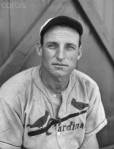 Pepper Martin, Cardinals, 1931
Pepper Martin, Cardinals, 1931
.500/.538/.792, 4 2B, 1 HR, 5 RBI, 5 SB, .735 WPA (7 games)
When I was a kid, this performance was always written about in the World Series books I’d read. Part of the story was Martin — a 27-year-old rookie — stealing five bases on Mickey Cochrane, at a time when players didn’t attempt many steals (he had 16 in the regular season). His big game was Game 5, when he went 3-for-4 with a two-run homer and four RBIs in a 5-1 win. In Game 7, he walked and stole second in the first inning, with Cochrane’s error allowing a runner on third to score. The Cardinals won 4-2.
Charlie Keller, Yankees, 1939
.438/.471/1.188, 3 HR, 6 RBI, 8 R, .984 WPA (4 games)
An underrated player who was on a Hall of Fame trajectory until a bad back shortened his career, Keller did a lot of damage as the Yankees swept the Reds for their fourth straight title.
Duke Snider, Dodgers, 1952
.345/.387/.828, 2 2B, 4 HR, 8 RBI, .919 WPA (7 games, lost)
Snider had put the Dodgers up 3 games to 2 with a home run and go-ahead double in the 11th inning. But the Yankees won the next two games, because that’s what the Yankees did in those days. Snider’s last at-bat was in the seventh inning, bases loaded and one out, Dodgers down 4-2. He popped out to third.
Yogi Berra, Yankees, 1956
.360/.448/.800, 3 HR, 10 RBI, .424 WPA (7 games)
Berra had one of the great Game 7 performances: He hit two-run homers in the first and third innings to stake the Yankees to a 4-0 lead and would finish 2-for-3 with two intentional walks in a 9-0 shutout over the Dodgers.
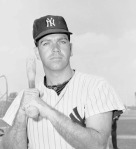 Bobby Richardson, Yankees, 1960
Bobby Richardson, Yankees, 1960
.367/.387/.667, 1 HR, 5 XBH, 12 RBI, 8 R, -.088 WPA (7 games, lost)
This was the Series where the Yankees won three blowouts, but the Pirates won four close ones. Richardson set the record with 12 RBIs, but you can see that his WPA was actually negative. He did most of his damage in the blowouts, including six RBIs in a 10-0 win in Game 3. In 1964, Richardson had 13 hits, still tied for the Series record.
Lou Brock, Cardinals, 1967
.414/.452/.655, 4 XBH, 3 RBI, 8 R, 7 SB, .514 WPA (7 games)
Brock had another big Series in 1968, hitting .464 and again stealing seven bases, although the Cardinals lost that one. Against the Red Sox in ’67, he was a terror on the bases, going 7-for-7 on steals. In Game 7, he went 2-for-4 with a walk and stole three bases in a 7-2 victory.
Brooks Robinson, Orioles, 1970
.429/.429/.810, 2 2B, 2 HR, 6 RBI, 5 R, .686 WPA (5 games)
This is the World Series where Robinson made several memorable plays in the field to help beat the Big Red Machine. But he also had a big series at the plate, including a 4-for-4 Game 4 (although the O’s lost that one 6-5).
Roberto Clemente, Pirates, 1971
.414/.452/.759, 5 XBH, 2 HR, 4 RBI, .425 WPA (7 games)
Clemente had played in the 1960 World Series as a young player and returned 11 years later as a grizzled veteran of 37. He had 12 hits, showed off his strong arm and had a home run in a 2-1 win in Game 7. Everyone finally realized how great he was.
Gene Tenace, A’s, 1972
.348/.400/.913, 4 HR, 9 RBI, 1.065 WPA (7 games)
Tenace would go on to a fine career, but was an obscure part-time player in 1972 when he had a monster World Series as the A’s beat the Reds. In Game 1, he homered twice and drove in all three runs in a 3-2 win. In Game 4, he singled in the ninth as the A’s scored twice to win 3-2. He hit a three-run homer in Game 5, although the Reds rallied to win 5-4. In Game 7, he singled in a run in the first and doubled in the tying run in the sixth and then scored the go-ahead run in a 3-2 victory. (Six of the games were decided by one run.) Tenace drove in nine of Oakland’s 16 runs. Talk about a one-man show.
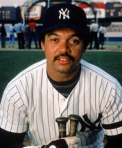 Reggie Jackson, Yankees, 1977
Reggie Jackson, Yankees, 1977
.450/.552/1.250, 5 HR, 8 RBI, 10 R, .564 WPA (6 games)
Reg-gie! Reg-gie! Reg-gie! Reggie capped off his Mr. October performance with three swings in Game 6 — all home runs.
Willie Stargell, Pirates, 1979
.400/.375/.833, 4 2B, 3 HR, 7 RBI, 7 R, .341 WPA (7 games)
Stargell’s 25 total bases is tied with Jackson’s 1977 total for the most ever in a World Series. Check out what he did in Game 7: 4-for-5, two doubles, a home run, a run and two RBIs as the Pirates beat the Orioles 4-1.
Johnny Bench, Reds, 1976
.533/.533/1.133, 2B, 3B, 2 HR, 6 RBI, .405 WPA (4 games)
Most of Bench’s damage came in the clincher: Two home runs, five runs batted in as the Reds finished off the Yankees.
Billy Hatcher, Reds, 1990
.750/.800/1.250, 4 2B, 1 3B, 2 RBI, 6 R, .563 WPA (4 games)
Hatcher’s .750 average remains the World Series record (Ortiz’s .688 is second). Hatcher went 3-for-3 in Game 1 and 4-for-4 in Game 2.
Lenny Dykstra, Phillies, 1993
.348/.500/.913, 4 HR, 8 RBI, 9 R, 7 BB, 4 SB, .631 WPA (6 games, lost)
Dykstra did everything except pitch in relief in this series. His three-run homer off Dave Stewart in the sixth inning of Game 6 appeared to send it to a Game 7 …
 Paul Molitor, Blue Jays, 1993
Paul Molitor, Blue Jays, 1993
.500/.571/1.000, 6 XBH, 2 HR, 8 RBI, 10 R, .839 WPA (6 games)
Molitor signed with Toronto hoping to finally win a World Series, and he did, while also winning MVP honors. In Game 6, he went 3-for-5 with a triple, home run and single that preceded Joe Carter’s home run.
Barry Bonds, Giants, 2002
.471/.700/1.294, 4 HR, 6 RBI, 8 R, 13 BB, .560 WPA (7 games, lost)
How feared was Bonds? The Angels intentionally walked him seven times. Alas, in Game 7, Bonds never came to bat with a runner on base and went 1-for-3 with a walk. The Giants would finally win a World Series after he had retired.
Chase Utley, Phillies, 2009
.286/.400/1.048, 5 HR, 8 RBI, 7 R, .217 WPA (6 games, lost)
Utley tied Reggie’s record of five home runs, and like Reggie, did it in six games. He homered twice in Game 1 and twice again in Game 5, both Phillies’ victories, but the Yankees won in six.
Hideki Matsui, Yankees, 2009
.615/.643/1.385, 3 HR, 8 RBI, .628 WPA (6 games)
Matsui’s eight-RBI performance was remarkable in part because he only started three of the six games, pinch-hitting in three non-DH games. His Game 6 was one of the best World Series games ever: 3-for-4, a double, home run and six RBIs in a 7-3 win.
Lance Berkman, Cardinals, 2011
.423/.516/.577, 1 HR, 5 RBI, 9 R, 5 BB, 1.002 WPA (7 games)
Check that out WPA. He drove in two runs in a 3-2 win in the opener. Then came the final two games. In Game 6, he had one of the most clutch World Series games you can imagine in that wild 10-9 Cardinals victory: 3-for-5 with a walk, homer, four runs and three RBIs. In the bottom of the ninth, he walked ahead of David Freese’s game-tying, two-run triple. In the 10th, down to their final out, Berkman singled in the tying run. In Game 7, he scored two runs. His Game 6 performance ranks fourth on the all-time single-game WPA list. Of course, it was overshadowed by …
David Freese, Cardinals, 2011
.348/.464/.696, 3 2B, 1 3B, 1 HR, 7 RBI, 5 BB, 1.086 WPA (7 games)
Freese’s .964 WPA in Game 6 — he hit the triple in the ninth and then the walk-off homer — is the highest in World Series history, with Kirk Gibson second for his pinch-hit heroics in 1988. In Game 7, the Rangers had scored twice in the top of the first, but Freese doubled home two runs with two outs in the bottom of the inning and the Cardinals went on to a 6-2 win.
David Ortiz, Red Sox, 2013
.688/.760/1.188, 2 2B, 2 HR, 6 RBI, 7 R, 8 BB, .943 WPA (6 games)
Ortiz tied Bonds’ mark of reaching base three-plus time in five games. The Red Sox hit just .211 in the series — .169 minus Ortiz’s numbers. He walked four times in Game 6 — and scored twice — as the Cardinals just stopped trying to get him out. That strategy didn’t work, either.
10 World Series performances, with “clutch” playing an important role:
10. Billy Hatcher, Reds, 1990. Hey, the guy hit .750 as the Reds stunned the A’s.
9. Pepper Martin, Cardinals, 1931. Rattled the A’s with his baserunning, hit .500.
8. Lance Berkman, Cardinals, 2011. Overshadowed by his teammate.
7. Paul Molitor, Blue Jays, 1993. Hit .500, monster game in the clincher.
6. Reggie Jackson, Yankees, 1977. Three home runs in Game 6.
5. Barry Bonds, Giants, 2002. Imagine what he would have done if the Angels had actually pitched to him.
4. Lou Gehrig, Yankees, 1928. Destroyed the Cardinals in a four-game sweep.
3. Gene Tenace, A’s, 1972. Extra points for clutch hitting and carrying the Oakland offense.
2. David Ortiz, Red Sox, 2013. Great triple-slash line and high WPA score.
1. David Freese, Cardinals, 2011. OK, hit just .348, but had the greatest clutch game in World Series history.
Well, it has been a while….
The opportunity to see the Boston Red Sox win a World Series at home for the first time in a lifetime has turned Game 6 at Fenway Park into the most expensive local ticket in the city’s history.
As of 10 a.m. ET Tuesday, the average list price on the resale market for a ticket to Wednesday night’s game was $1,860, according to TiqIQ, a ticket tracking company.
Bleacher seats to the game, which could have been had for $300 last week, were selling for $1,100 on Tuesday morning.
On Monday night, someone who wanted two of the best seats in the house paid $24,000 on StubHub for a pair of tickets in the first row in a dugout box between home plate and one of the on-deck circles.
“There was this type of excitement in 2004 for the Red Sox home games because people thought it would never come again,” said Jim Holzman of Ace Ticket, a Boston-based brokerage that has been in business for 33 years.
The Red Sox went on to win the World Series in 2004 and again in 2007, ending it on the road both times. The last time the Red Sox won it all in Boston was with a victory over the Chicago Cubs on Sept. 11, 1918.
“People want to see them win it here,” Holzman said. “That’s what has made this the biggest ticket we’ve ever seen. It’s the Super Bowl except people don’t have to pay $1,000 for a hotel and $2,000 for airfare.”
Holzman said fans began buying tickets in earnest Monday night after the Red Sox scored in the top of the first inning during their 3-1 Game 5 victory over the St. Louis Cardinals.
“Prices were going up $50 an inning,” Holzman said.
Let’s take a look back some highlights of that infamous 1918 Series:
The 1918 World Series featured the Boston Red Sox, who defeated the Chicago Cubs four games to two. The Series victory for the Red Sox was their fifth in five tries, going back to 1903. The Red Sox scored only nine runs in the entire Series; the fewest runs by the winning team in World Series history. Along with the 1906 and 1907 World Series, the 1918 World Series is one of only three Fall Classics where neither team hit a home run.
The Series was held early in September because of the World War I “Work or Fight” order that forced the premature end of the regular season on September 1, and remains the only World Series to be played entirely in September.
 The Chicago home games in the series were played at Comiskey Park, which had a greater seating capacity than Weeghman Park, the prior home of the Federal League Chicago Whales that the Cubs were now using and which would be rechristened Wrigley Field in 1925. The Red Sox had played their home games in the 1915 and 1916 World Series in the more expansive Braves Field, but they returned to Fenway Park for the 1918 series.
The Chicago home games in the series were played at Comiskey Park, which had a greater seating capacity than Weeghman Park, the prior home of the Federal League Chicago Whales that the Cubs were now using and which would be rechristened Wrigley Field in 1925. The Red Sox had played their home games in the 1915 and 1916 World Series in the more expansive Braves Field, but they returned to Fenway Park for the 1918 series.
Game 1 of the 1918 World Series marked the first time “The Star Spangled Banner” was performed at a major league game. During the seventh inning stretch, the band began playing the song due to the fact the country was involved in World War I. The song would be named the national anthem of the United States in 1931, and during World War II its playing would become a regular pregame feature of baseball games and other sporting events. The winning pitcher of Game 1 was none other than Babe Ruth, who pitched a shutout.
The Red Sox, who had won the American League but lost the Series in 1946, 1967, 1975, and 1986, finally won the World Series in 2004 and then won again in 2007. The drought of 86 years was often attributed to the Curse of the Bambino. The alleged curse came to be when the Red Sox traded the superbly talented but troublesome Babe Ruth (who was instrumental in their 1918 victory) to the New York Yankees for cash after the 1919 season.
Game 6
Wednesday, September 11, 1918 at Fenway Park in Boston, Massachusetts
Attendance for Game 6 at Fenway on Wednesday, September 11, was down from over 24,000 on Tuesday to a mere 15,238, but the Red Sox went home happy. Max Flack’s third-inning error allowed two Sox runs to score, which were all they needed for a 2–1 victory and the World’s Championship of 1918 behind Carl Mays’ second win of the Series.
| Team | 1 | 2 | 3 | 4 | 5 | 6 | 7 | 8 | 9 | R | H | E | |||||||||||
|---|---|---|---|---|---|---|---|---|---|---|---|---|---|---|---|---|---|---|---|---|---|---|---|
| Chicago | 0 | 0 | 0 | 1 | 0 | 0 | 0 | 0 | 0 | 1 | 3 | 2 | |||||||||||
| Boston | 0 | 0 | 2 | 0 | 0 | 0 | 0 | 0 | X | 2 | 5 | 0 | |||||||||||
| WP: Carl Mays (2–0) LP: Lefty Tyler (1–1) | |||||||||||||||||||||||
After Game 6, it would be some 87 years until the Cubs and Red Sox would play again. A three-game interleague matchup at Wrigley Field began June 10, 2005 and was Boston’s first ever visit to the park. The Cubs would not return to Fenway Park for nearly 94 years until a three-game interleague matchup beginning May 20, 2011.
BBWA, We need to talk…
If David Ortiz gets into the Hall of Fame, people will point to the 2013 World Series as the stretch that put him over the top.
 Before this postseason, Ortiz had already established himself as a clutch playoff performer en route to Red Sox championships in 2004 (two walk-off hits) and 2007, but this October might just be his best one yet. We’ll acknowledge that his ALCS performance was subpar overall (just two hits in six games), but one of those hits was a Game 2 grand slam that rallied the Sox past the Tigers and served as the turning point in the series.
Before this postseason, Ortiz had already established himself as a clutch playoff performer en route to Red Sox championships in 2004 (two walk-off hits) and 2007, but this October might just be his best one yet. We’ll acknowledge that his ALCS performance was subpar overall (just two hits in six games), but one of those hits was a Game 2 grand slam that rallied the Sox past the Tigers and served as the turning point in the series.
In the World Series, he’s been untouchable, as locked in as perhaps any player in postseason history.
Consider the following:
• He is 11-of-15 (.733 batting average) against the Cardinals with six runs batted in, four extra-base hits, four walks and no strikeouts. He has an OPS of 2.017 (let that one sink in). Those 11 hits are two shy of the record for most in a World Series, which is shared by Bobby Richardson (1964 Yankees), Lou Brock (1968 Cardinals) and former Red Sox second baseman Marty Barrett (1986 Red Sox). The only player other than Ortiz in major league history to reach base (by hit, walk or HBP) at least 15 times over the first five games of a World Series is Barry Bonds in 2002.
• As a team, the Red Sox are hitting .205 in the World Series. If you take away Ortiz, that number drops to .151.
• Ortiz became the third player to reach base safely in nine straight plate appearances in the World Series, according to the Elias Sports Bureau, joining Joe Gordon (1939/1941 Yankees) and Billy Hatcher (1990 Reds). Ortiz and Hatcher are the only two to do so in a single World Series.
“I’ve got my mindset. I’ve been playing this game for too long, and when I go to the plate, I try to look for a strike and try not to get out of it,” Ortiz said after Monday night’s Game 5 victory. “And that’s pretty much what I’ve been doing all year.”
• He became the first Red Sox player ever with consecutive three-hit games in the World Series. According to Elias, Ortiz (37) is the oldest player in MLB history with back-to-back three-hit games in the World Series.
• With his first-inning RBI in Game 5, Ortiz now has 14 career RBIs in the World Series. That ties the team record, held by Dwight Evans.
• Among players with at least 40 World Series at-bats, Ortiz has the highest OPS in major league history.
• Unlike other Cardinals pitchers, Game 5 starter Adam Wainwright challenged Ortiz instead of working around him. Wainwright changed his windup to try to disturb Ortiz’s timing. The slugger still went 3-for-4.
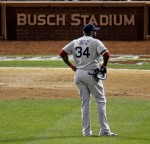 “I wasn’t paying any attention to that,” Ortiz said. “To be honest with you, he threw me some tough pitches tonight. He was throwing me cutters in. And I know that pretty much after he gets ahead with two strikes, he wants to strike me out with a breaking ball. So you make up your mind. It’s a battle when you face that kind of pitcher, as good as he is, and as good as the rest of the pitchers that they have — they have a great pitching staff. And if you try to look for everything they throw, you definitely are not going to hit anything.”
“I wasn’t paying any attention to that,” Ortiz said. “To be honest with you, he threw me some tough pitches tonight. He was throwing me cutters in. And I know that pretty much after he gets ahead with two strikes, he wants to strike me out with a breaking ball. So you make up your mind. It’s a battle when you face that kind of pitcher, as good as he is, and as good as the rest of the pitchers that they have — they have a great pitching staff. And if you try to look for everything they throw, you definitely are not going to hit anything.”
Ortiz has been at his best in the seasons in which the Red Sox reached the World Series (perhaps not coincidentally). In 2004, he reached base in 13 of 14 games and had back-to-back walk-off hits in the ALCS against the Yankees. He had 19 RBIs during that playoff run with a .400 average, .515 OBP and 1.278 OPS. In 2007, he put up a similar line: He reached base in 13 of 14 games, had a .370 average, .508 OBP and 1.204 OPS.
Even factoring in his below-standard ALCS performance this October, he has reached base in 13 of 15 games and has a .360 average, .476 OBP and 1.196 OPS.
“I was born for this,” Ortiz said after Boston’s Game 5 victory.
Most Hits By A Red Sox Player In A Single World Series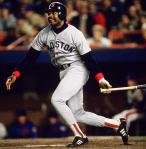
| Player | Year | Opponent | Hits |
|---|---|---|---|
| Marty Barrett | 1986 | Mets | 13 |
| David Ortiz | 2013 | Cards | 11 |
| Dave Henderson | 1986 | Mets | 10 |
| Carl Yastrzemski | 1967 | Cards | 10 |
| Chick Stahl | 1903 | Pirates | 10 |
Highest Career OPS In World Series History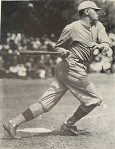
| Player | OPS | Team(s) |
|---|---|---|
| David Ortiz | 1.370 | BOS |
| Lou Gehrig | 1.214 | NYY |
| Babe Ruth | 1.214 | BOS/NYY |
| Reggie Jackson | 1.212 | OAK/NYY |
| > Minimum 40 ABs | ||
David Ortiz In Postseasons In Which Red Sox Reached World Series
| Year | Reached Base | AVG | OBP | OPS |
|---|---|---|---|---|
| 2004 | 13 of 14 games | .400 | .515 | 1.278 |
| 2007 | 13 of 14 games | .370 | .508 | 1.204 |
| 2013 | 11 of 15 games | .360 | .476 | 1.196 |
| > In 2013 World Series, Ortiz is 11 of 15 (.733) with a .750 OBP and 2.017 OPS | ||||
Time Changes All Things…. Even the LineUp Card
Red Sox manager John Farrell said that Shane Victorino’s back strain is much improved and he will be available off the bench in Game 5 Monday night, but there were still questions about how long he could go if he started, so he’s not in the lineup.
Farrell said he expects Victorino to be able to start Game 6 in Boston.
Farrell also made a small but significant change to his batting order, sliding Dustin Pedroia, David Ortiz and Gomes up one spot in the order, with Nava dropping from second to fifth. Farrell said he did so to “lengthen” the lineup behind Ortiz, who is batting .727 (8 for 11) in the Series and has reached base safely seven consecutive times, his on-base average at .750.
As for his bullpen for Game 5, Farrell said Game 3 starter Jake Peavy will be available, and that he would turn to left-hander Felix Doubront, who has pitched in back-to-back games for the first time since 2011, “only in an emergency.’’
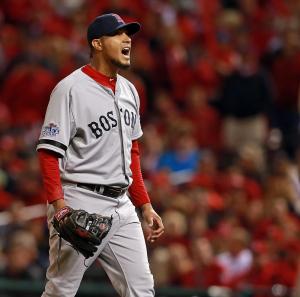 Farrell praised Doubront for his work the past two nights, “especially in this environment, his poise and control, and the way he attacked the strike zone.’’
Farrell praised Doubront for his work the past two nights, “especially in this environment, his poise and control, and the way he attacked the strike zone.’’
Doubront would appear to loom as a potential option in the event Farrell elects not to start Peavy in Game 7, especially since the Cardinals hit right-handers significantly better (.278/.340/.413/.753) than left-handers (.242/.309/.366/.675) in the regular season. However, the Cardinals routed baseball’s best pitcher, Dodgers left-hander Clayton Kershaw, 9-0, in the deciding game of the NLCS.
Left-hander Craig Breslow, who has retired only one of seven batters he’s faced in the World Series (the out came on a sacrifice fly), looks “a little bit tentative — he hasn’t settled in against their lineup,’’ Farrell said. “He doesn’t have the same familiarity with them as he does with the American League lineups.’’
In something of a surprise, Farrell said that Game 4 starter Clay Buchholz came to him Monday and volunteered to pitch out of the pen when the Series returns to Boston on Wednesday. Game 2 starter John Lackey did the same thing last week, Farrell said, and pitched a scoreless eighth inning Sunday night.
“The way [Buchholz] came out of [Sunday’s start], he told me last night he would be in here [Monday] to get ready for another opportunity,’’ Farrell said. “By no means has he shut down anything physically or mentally.
“When he came back to the dugout after the second inning, he said, ‘I haven’t even tried to throw the ball hard yet,’’’ Farrell said. “I said, ‘Based on what’s happened, you don’t need to.’ He has such feel and can manipulate the ball, even when he’s lacking power, his cutter and two-seamer are very effective.’’
Asked about his rotation plans, Farrell said that as far as Peavy starting Game 7, “everything points to that right now,’’ but added, “Everybody’s available in Game 7.’’
For Game 5, Allen Craig, who has been dealing with a foot injury, was a late addition to the Cardinals lineup. He will bat sixth and play first base. Also, Mike Matheny moved Carlos Beltran, who batted second in an 8-1 loss to Game 5 starter Jon Lester in Game 1, will hit cleanup behind Matt Holliday. Shane Robinson, who hit eighth in Game 1, will bat second.
Game 5, Like Deja Vu all over again
• Starting pitchers: Adam Wainwright (19-9, 2.94 ERA) vs. Jon Lester (15-8, 3.75 ERA)
• Scouting report on Wainwright: Not much went right for Wainwright in Game 1 against the Red Sox. A seven-pitch walk to Jacoby Ellsbury in the first was only the start of the 32-year-old’s rough night as he allowed three runs in the opening inning, partly due to poor defensive play behind him. However, with the series tied 2-2, Wainwright has another crack at giving his team the advantage moving forward.
“It’s a pretty clean slate [from my last start],” Wainwright said Sunday in his news conference at Busch Stadium. “I honestly don’t know why my mechanics were as bad as they were [and] my delivery was off as much as it was. But I feel like I’ve put a lot of good reps in in front of the mirror and watching film and feeling my delivery again.”
“I feel like I’ve made a lot of good adjustments to be ready for this next game to throw some quality pitches.”
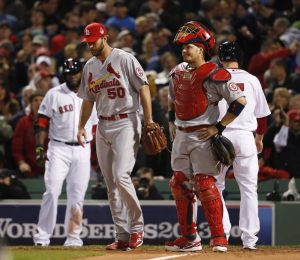 In his Game 1 start, Wainwright’s curveball was his best pitch. He used his curveball for 15 of his final 33 pitches, a span that saw him retire seven straight batters before allowing a David Ortiz single in the fifth inning that he was able to pitch around. Overall, Wainwright went five innings, allowing five runs (three earned) on six hits and striking out four.
In his Game 1 start, Wainwright’s curveball was his best pitch. He used his curveball for 15 of his final 33 pitches, a span that saw him retire seven straight batters before allowing a David Ortiz single in the fifth inning that he was able to pitch around. Overall, Wainwright went five innings, allowing five runs (three earned) on six hits and striking out four.
“I learned that they hit mistakes,” Wainwright said of his first career start against Boston last Wednesday. “And I learned that if I make mistakes in the middle of the plate up in the zone, they’re going to hit them.”
Overall, Wainwright is 2-2 in his four postseason starts with a 2.25 ERA. The right-hander has allowed seven runs (five earned) in his past 12 innings after allowing only two runs in his first 16 innings pitched of the playoffs.
• Scouting report on Lester: Putting aside the speculation that he was in some way doctoring his pitches in Game 1, Lester pitched masterfully, shutting out the Cardinals’ potent offense for 7 2/3 innings and striking out eight batters. The start was yet another in a string of successful starts Lester has made in October, something he says he doesn’t know how to explain.
“I feel like I’ve pitched pretty [well] throughout most of my seasons, and it’s just carried over into the postseason,” Lester said Sunday. “I don’t know what it is. I like this stage. I like knowing that I’ve got to go out there and give everything I’ve got for my teammates, because tomorrow might be our last game. You don’t know; I guess that just gives you that little extra focus.”
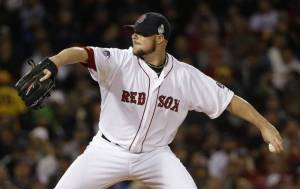 Of Lester’s 10 career postseason starts, seven have been of the quality variety — at least six innings pitched and three runs or fewer allowed. The 29-year-old has gone 5-4 in 12 postseason appearances overall, posting a 2.22 ERA. Of his 69 postseason innings pitched, 13 1/3 have come in the World Series, where he has yet to allow a run.
Of Lester’s 10 career postseason starts, seven have been of the quality variety — at least six innings pitched and three runs or fewer allowed. The 29-year-old has gone 5-4 in 12 postseason appearances overall, posting a 2.22 ERA. Of his 69 postseason innings pitched, 13 1/3 have come in the World Series, where he has yet to allow a run.
“I think the one thing that we all recognize is that the power stuff wins in the postseason,” Red Sox manager John Farrell said Sunday. “He’s got it, he maintains it, and yet, in addition to his physical strengths, there’s a level of concentration that he’s capable of maintaining that gives him the ability to execute consistently over the time he’s on the mound. Those two things combined are what’s given [him] the career performance he’s had in the postseason.”
This will be the first time in his career that Lester has made five starts in a single postseason.
Three Cardinals players to watch
• Carlos Beltran, RF: Beltran was only given one shot at Lester in Game 1, striking out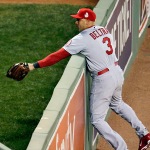 swinging on four pitches before being removed from the game due to a rib contusion. Beltran has three hits in 10 World Series at-bats so far, two of which have come in his two at-bats with runners in scoring position. Beltran was left with a bat in his hand at home plate in the ninth inning of Game 4 after Kolten Wong was picked off first base to end the game.
swinging on four pitches before being removed from the game due to a rib contusion. Beltran has three hits in 10 World Series at-bats so far, two of which have come in his two at-bats with runners in scoring position. Beltran was left with a bat in his hand at home plate in the ninth inning of Game 4 after Kolten Wong was picked off first base to end the game.
• David Freese, 3B: Since singling in the ninth inning of Game 1, Freese has been held hitless in his past eight at-bats, a streak that’s resulted in him being dropped to seventh in the order. Of the 13 runners he’s left on base the past four games, six have been left in scoring position.
• Pete Kozma, SS: In keeping with pattern, manager Mike Matheny has selected Kozma to start at short in Games 1 and 3 while going with Daniel Descalso in Games 2 and 4. The difference between the two has been a wash offensively, as Descalso is 0-for-6 while Kozma is 0-for-8 through the first four games of the series. However, Kozma was the only St. Louis Cardinals hitter to not strike out in Game 1, seeing 13 pitches in his three plate appearances.
Three Red Sox players to watch
• David Ortiz, 1B: A lot of the talk leading into the World Series was about how many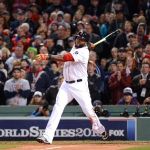 games Ortiz would play at first base over Mike Napoli. But Ortiz has ended that conversation, with a gaudy .727 batting average, a result of eight hits in 11 at-bats. His eight hits have accounted for a third of the Red Sox’s total in the series (24). He also has two of Boston’s three homers and he leads the team in RBI (5) and runs (5). He has collected hits in his past four at-bats and is the only Boston starter to not strike out so far.
games Ortiz would play at first base over Mike Napoli. But Ortiz has ended that conversation, with a gaudy .727 batting average, a result of eight hits in 11 at-bats. His eight hits have accounted for a third of the Red Sox’s total in the series (24). He also has two of Boston’s three homers and he leads the team in RBI (5) and runs (5). He has collected hits in his past four at-bats and is the only Boston starter to not strike out so far.
• Jonny Gomes, LF: With outfielder Shane Victorino’s status still unknown following his late scratch before Game 4, Gomes re-proved his worth in the lineup to Farrell by hitting what turned out to be the game-winning three-run home run for Boston in the sixth inning, ending his 0-for-9 skid to start the World Series. Gomes also worked a 10-pitch walk in the fifth and a six-pitch walk in the eighth inning of Sunday’s game, a step back on the right track for a player with whom Boston has won eight of nine postseason starts.
• Xander Bogaerts, 3B: Bogaerts started off the series going 0-for-6 with four strikeouts in Games 1 and 2 before turning it on in St. Louis to collect three hits in his past seven at-bats. The 21-year-old’s .231 average is third on the team behind Ortiz (.727) and Dustin Pedroia (.267).
Three key considerations:
• Red Sox reliever Junichi Tazawa has appeared in all four World Series games, the only pitcher on either team to do so. Farrell has used Tazawa to face just one batter in three of his four appearances, something the 27-year-old did in only two of his 71 appearances during the regular season.
• Sunday night’s win guaranteed that the series will shift back to Fenway Park for at least a Game 6. So far this postseason, Boston is 5-2 at home compared to 4-3 on the road.
• David Ross will be back behind the plate in Game 5, according to Farrell. Ross has  caught all four of Lester’s starts this postseason, including Game 1 where he went 1-for-2 against Wainwright. It will be Ross’s second consecutive start since regular starter Jarrod Saltalamacchia made a throw that led to the obstruction call that ended Game 3.
caught all four of Lester’s starts this postseason, including Game 1 where he went 1-for-2 against Wainwright. It will be Ross’s second consecutive start since regular starter Jarrod Saltalamacchia made a throw that led to the obstruction call that ended Game 3.
10 Reasons to get Excited about the 2013 World Series
This probably isn’t the World Series most baseball folks wanted, assuming you don’t root for the Red Sox or Cardinals. After all, both franchises have been to the World Series multiple times in the past decade and both have won twice. So maybe you wanted some new blood.
Instead you’ll get beards. Lots of them.
But you also get two great teams, with no shortage of reasons to watch. Here are 10:
1. Adam Wainwright. He was a rookie closer when the Cardinals won the World Series in 2006 but was injured when they won again in 2011. In a season where much of the attention for pitchers went to Clayton Kershaw, Max Scherzer, Matt Harvey and Mariano Rivera, Wainwright quietly went 19-9 with a 2.94 ERA while leading the majors in innings pitched. This is his chance to make his October mark in Cardinals history alongside the likes of Bob Gibson and his mentor Chris Carpenter, who won two games in the 2011 World Series. He has that big curveball — maybe the best since Bert Blyleven was spinning his own — that he’ll throw on any count but is especially deadly with two strikes, when opponents hit .118 with 130 strikeouts in 238 plate appearances.
2. David Ortiz versus Carlos Beltran. They’re not facing each other, but you sort of get the feeling they are. Few hitters have delivered in their playoff careers like these two, although Ortiz did go just 2-for-22 in the American League Championship Series. Beltran had six RBIs in each of the Cardinals’ first two series and now gets the opportunity to play in his first World Series … and perhaps make a Hall of Fame statement.
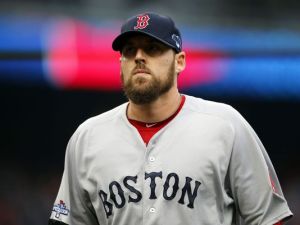 3. John Lackey’s redemption. Two years ago he was the most hated man in Boston after posting a 6.41 ERA in 28 starts and ordering lots of fried chicken between starts. Now, after beating Justin Verlander 1-0 in the ALCS, he’s going to start Game 2 of the World Series. Remember, he’s familiar with the pressures of a big game: As a rookie with the Angels in the 2002 World Series, he was the winning pitcher in Game 7.
3. John Lackey’s redemption. Two years ago he was the most hated man in Boston after posting a 6.41 ERA in 28 starts and ordering lots of fried chicken between starts. Now, after beating Justin Verlander 1-0 in the ALCS, he’s going to start Game 2 of the World Series. Remember, he’s familiar with the pressures of a big game: As a rookie with the Angels in the 2002 World Series, he was the winning pitcher in Game 7.
4. Yadier Molina. One of the memories of the 2011 World Series that stuck with me was the ovations Molina received from his home fans — louder than those given Albert Pujols. Perhaps Cardinals fans anticipated Pujols’ departure, or maybe they just appreciated everything Molina does for the team, from his hitting to his defense to the confidence he instills in his pitchers. Few players ever perfect their jobs on a baseball field, but you get the idea Molina has perfected playing catcher. Appreciate and enjoy. And then see if the Red Sox — who set the all-time record for stolen-base percentage (123 for 142) — attempt to run on him.
5. Power versus RISP. Each team led its league in runs scored, just the fourth time since 1976 that’s happened (1976, Reds-Yankees; 2004, Cardinals-Red Sox; 2009, Phillies-Yankees), but did so in different ways. The Red Sox, while not as powerful as some Red Sox teams of the past, hit 178 home runs (sixth in the majors), but also pounded out 363 doubles (first) and drew 581 walks (third). The Cardinals ranked 27th in the majors in home runs and don’t steal many bases (just 45), but they put the ball in play, an attribute that allowed them to hit .330 with runners in scoring position, the highest figure in the majors since that stat has been recorded beginning in 1961. The Red Sox beat the Tigers largely because of three key home runs — the grand slams from Ortiz and Shane Victorino plus Mike Napoli’s solo shot in the 1-0 victory in Game 3 — and while the Cardinals have hit just .210 in the postseason they’ve hit .286 with RISP.
6. Michael Wacha. In the span of 16 months he’s gone from Texas A&M to … well, almost unhittable. In his past four starts, going back to his final outing of the regular season, he’s allowed an .093 batting average — 9 for 97. In his three postseason starts, he’s allowed one run for a tidy 0.43 ERA. He has a chance to become just the sixth pitcher to have four starts in one postseason where he allowed one run or less, joining Blue Moon Odom (1972), Burt Hooton (1981), John Smoltz (1996), Ryan Vogelsong (2012) and Curt Schilling (2001, the only one with five). I can’t wait to see what the rookie does.
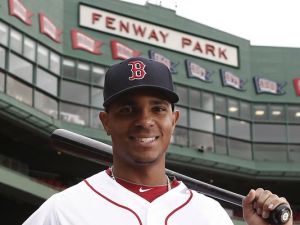 7. Xander Bogaerts. He just turned 21 and had just 18 games of big-league experience before the playoffs began. Now he may be starting at third base, like he did the final two games of the ALCS. He’s going to be a big star down the road so this is kind of like a sneak preview. He’s had 11 plate appearances in the playoffs and drawn five walks while going 3-for-6. How can a kid have such a mature approach at the plate?
7. Xander Bogaerts. He just turned 21 and had just 18 games of big-league experience before the playoffs began. Now he may be starting at third base, like he did the final two games of the ALCS. He’s going to be a big star down the road so this is kind of like a sneak preview. He’s had 11 plate appearances in the playoffs and drawn five walks while going 3-for-6. How can a kid have such a mature approach at the plate?
8. Cardinals relievers. Speaking of kids, the Cardinals’ top four relievers right now — Trevor Rosenthal, Carlos Martinez, Kevin Siegrist and Seth Maness — are all rookies. Teams have won before with rookie closers — Bobby Jenks of the White Sox in 2005, Wainwright in 2006 — and the Cardinals had some inexperienced relievers in 2011. But four rookie relievers in key roles? (Five if you include starter Shelby Miller working out of the bullpen.) How can you not be pumped watching Rosenthal and Martinez throwing 100 mph in the eighth and ninth innings?
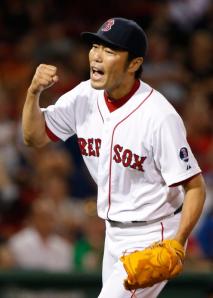 9. Koji Uehara’s splitter. It’s the most dominant 81 mph pitch in baseball history, a force of nature that breaks the natural laws of baseball, a pitcher who turns skilled batsmen into helpless amateurs. Including the postseason, batters are hitting .134 off Uehara. Against the splitter, they’re hitting .096. Since the All-Star break, they’re hitting .074 against the splitter, just 6-for-81 with 37 strikeouts and no walks. He’s 38 years old and basically the opposite of the gas-throwing Rosenthal and Martinez. The contrast in styles should make for some exciting late-game drama. One more thing: In what other sport could a 38-year-old guy, who while a good pitcher was never to be confused with Mariano Rivera, suddenly have a year better than any season Rivera ever had?
9. Koji Uehara’s splitter. It’s the most dominant 81 mph pitch in baseball history, a force of nature that breaks the natural laws of baseball, a pitcher who turns skilled batsmen into helpless amateurs. Including the postseason, batters are hitting .134 off Uehara. Against the splitter, they’re hitting .096. Since the All-Star break, they’re hitting .074 against the splitter, just 6-for-81 with 37 strikeouts and no walks. He’s 38 years old and basically the opposite of the gas-throwing Rosenthal and Martinez. The contrast in styles should make for some exciting late-game drama. One more thing: In what other sport could a 38-year-old guy, who while a good pitcher was never to be confused with Mariano Rivera, suddenly have a year better than any season Rivera ever had?
10. The best against the best. For the time since 1999, the teams with the best records in the majors will face off in the World Series. For the time since 2004, the teams with the best run differentials will face off. The rejuvenated, bearded Red Sox against the youthful, talented Cardinals. Players trying to create postseason legacies, others trying to add to existing ones. Big stars and future stars on the rise. It’s a World Series that has the elements for a classic duel. I think we’re going to get one.
A little History of our Game 1 History…
With Game 1 of the 2013 World Series between the Boston Red Sox and the St. Louis Cardinals only a few hours away, here’s a look back at the first games of the 2004 and 2007 Fall Classic.
In 2004, Red Sox second baseman Mark Bellhorn hit a two-run homer off reliever Julian Tavarez in the bottom of the eighth inning that rang off the right-field foul pole to lead Boston to an 11-9 win over the St. Louis Cardinals.
Red Sox DH David Ortiz (please note the St. Louis catcher in the photo above) hit a three-run homer and finished with four RBIs. Closer Keith Foulke recorded the final five outs of the game.
In 2007, the Red Sox crushed the Colorado Rockies 13-1 at Fenway Park. Rookie second baseman Dustin Pedroia led off the bottom of the first inning with a home run and the Red Sox never looked back. Starter Josh Beckett worked seven strong innings and allowed one run on six hits with nine strikeouts.
The Red Sox swept both of those series in four games.
